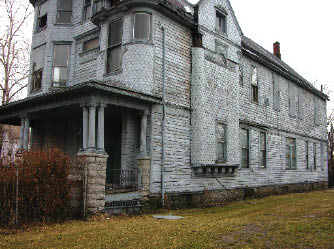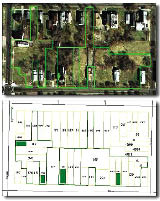The City Bountiful
by Gabe Armstrong

It’s rare that the words “city” and “farm” are uttered in the same breath. In Buffalo this might soon become commonplace.
Rod McCallum, a community activist, has an urban farm in mind for the city’s near East Side. He recently laid eyes upon the mostly derelict block bound by East Utica, Purdy, Masten and Glenwood streets. The block is dotted by boarded-up houses and vacant lots where many homes once stood.
At the center of this block stands an architecturally lush and spatially grand Queen Anne-style home, now called the “Engel House” by local housing activists, which has sat vacant since the fall of 2005. The house is directly across the street from Public School #8, just around the corner from the African-American Cultural Center on Masten and a few short blocks away from the recently built Merriweather Library. In a bigger development context, it’s just four blocks away from the developing Artspace project and three short blocks away from the future home of Performing Arts High School.
McCallum’s goal is to make this house the centerpiece of an ambitious project to turn much of this moribund block into an organic urban farm. The initial plan calls for renovating the house into a community gathering spot and headquarters of Queen City Farm. The house was built in 1889 by a produce merchant named Louis Engel. He had a warehouse on Michigan Avenue where the Senecas continue construction on a proposed casino.
“The craftsmanship and detail found in this home is second to none and is irreplaceable if it isn’t removed from the city’s demolition list,” says McCallum.
For the proposed farmland, McCallum is requesting the use of 19 city-owned lots, of which four have vacant houses still standing and awaiting demolition. If the plan comes to fruition, most of this block could become a lush oasis of organic gardens. McCallum adds, “This property has 2.5 acres of vacant, city-owned property. There are many areas of Buffalo where houses once stood but this particular block is deeper than most, which provides a large amount of land for cultivation.”
He first found out about this piece of land after seeing photos of 194 East Utica posted several times on FixBuffalo, a popular blog which focuses on rapidly deteriorating housing and rampant blight mainly in the Cold Spring and Midtown neighborhoods on the near East Side. McCallum notes that these parts of the city are just starting to see an influx of new public investment, citing Performing Arts and Artspace as indicators that this neighborhood eventually might become a hub of arts and education.

The blog’s author, David Torke, who lives in the neighborhood, has been trying for several years to bring attention to the abandoned house and the area around it.
He sees conditions on the East Side as being endemic of Buffalo’s status as a shrinking city, often writing about the rapid spread of grassy vacant land on the East Side, a phenomenon known as “urban prairie,” where once-dense urbanized land reverts back to nature.
“My own block used to have 20 houses on it 10 years ago. Now there are 14. Three years ago, 10 of them were occupied. Two years ago, seven, and today just four of the 14 are really occupied,” Torke says.
Yet, despite all the doom and gloom, he is optimistic about his corner of the East Side eventually rebounding.
“There are a number of amazing and architecturally significant houses owned by the city here in the Artspace backyard neighborhood and Midtown,” Torke points out. “Many of the them, despite the decay, are in structurally sound condition and just ready for urban homesteading. Like how about a Queen Anne home for one dollar, with the promise to rehab it and be part of the community?”
But because willing and able rehabbers aren’t exactly a dime a dozen, there is a seemingly endless supply of unwanted houses and former retail spaces in parts of the city like the Masten District, where McCallum’s proposed Queen City Farm will happen if things go as planned. As a result of the anemic demand for these houses, agricultural land use seems like a no-brainer. Other cities like Detroit and Los Angeles have already had several successful urban farming projects. In Buffalo, urban farming makes sense especially in a neighborhood where good food is often hard to come by.
There are many objectives to projects like Queen City Farm, like building local economies, saving energy resources and facilitating community education about food, health and sustainability. “Urban agriculture provides opportunities to engage youth in proactive and constructive activities that build self-esteem and work to empower youth to be entrepreneurial,” McCallum says.

“Urban agriculture makes fresh, locally grown food more widely available and reduces the need for shipping and preservatives. Low-income urban residents tend to have fewer shopping choices for healthy foods, and often pay more. Urban farms provide a range of products and help ensure long-term food security for the community. Supporting urban agriculture improves city environments, reconnects urban populations with active resource management, and promotes biodiversity within cityscapes.”
Many neighborhoods in the city are plagued with a poor access to fresh and nutritional food. This is harmful to children especially. The impact of poor nutrition on children’s health is severe. According to the USDA, poor nutrition stunts growth and learning and weakens the body’s ability to fight infections. Also, vitamin and mineral deficiencies put children at risk for behavioral developmental disorders. Food-insecure children are prone to the infection-malnutrition cycle, increasing their risk of severe illness and hospitalization.
Improving nutrition for neighborhood kids is just one goal of urban agriculture. It can also help reweave fragmented communities.
“Urban agriculture also provides opportunities for cross-generational interaction,” McCallum says. “Seniors often have much more expertise and knowledge about gardening than young people, and with a senior center a block away there will be many opportunities for youth and senior to work side-by-side on the farm.”
McCallum says the first phase of this project will involve raising $50,000 to fix up 194 East Utica—funds he hopes to raise by asking for $100 from 500 people. If this happens, the house will be fixed up into mixed community space and cooperative housing. Once renovation work is complete, McCallum and his large team of volunteers will team up with groups like the Massachusetts Avenue Project (MAP) to do everything necessary to prepare the acquired lots for growing food. MAP has established a sturdy reputation for carrying out urban farming programs on the West Side. Portions of the farm will be planted in the spring of 2008 and the rest of the property will be cultivated as it is ready over the following two years, according to McCallum.
He explains how this project will have an overall benefit for this struggling neighborhood and the entire city.
“This is a neighborhood that is close to downtown and exactly halfway between Canisius College and the Medical Campus. This is an area that should be teeming with vitality and for whatever reason is not. Urban agriculture will benefit this area because it provides green space amid the ongoing re-population efforts that engages city youth, seniors and disadvantaged residents on a daily basis.”
More information on Queen City Farm can be found at queencityfarm.org.
|
Issue Navigation> Issue Index > v6n13: The Trials of Ralph Hernandez (3/29/07) > The City Bountiful This Week's Issue • Artvoice Daily • Artvoice TV • Events Calendar • Classifieds |









 Current Issue
Current Issue